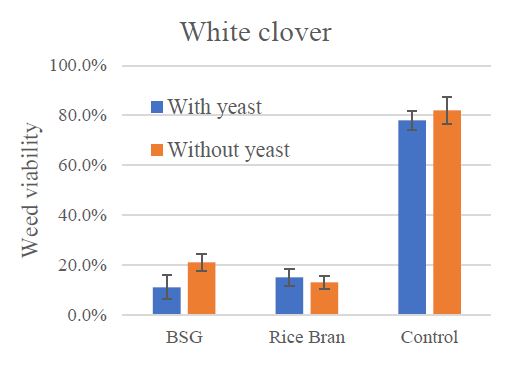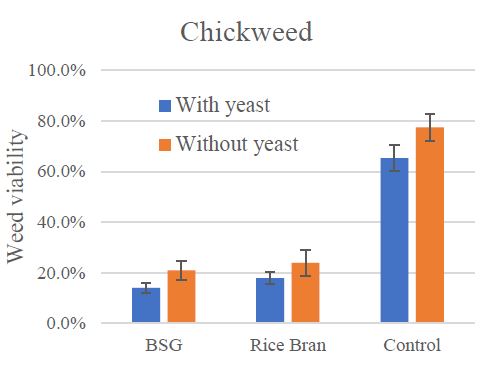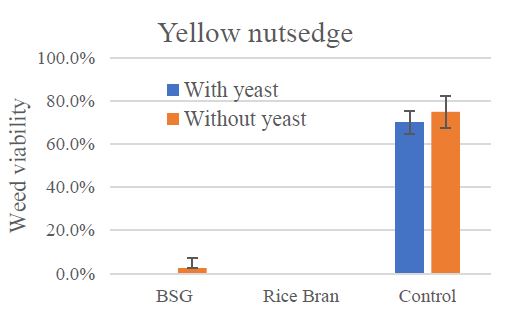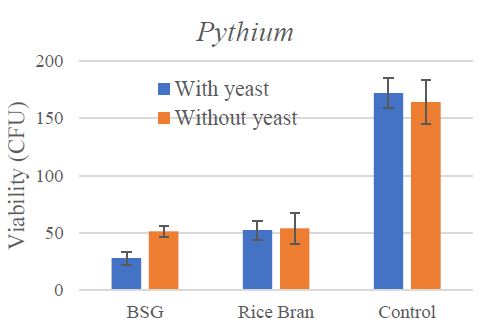Danyang Liu, Jayesh Samtani, Jeffrey Derr, Charles Johnson, Xuemei Zhang, Virginia Tech. and David Butler, University of Tennessee
Anaerobic soil disinfestation (ASD) is a promising preplant method that could be a potential alternative to chemical fumigation. Anaerobic soil disinfestation involves incorporating carbon amendments into the soil of beds to be planted, covering the bed with black polyethylene tarp, and irrigating the soil to field capacity. The effectiveness of ASD in pest suppression could be influenced by multiple factors, including environmental conditions, application rates, and properties of the carbon sources used. Most importantly, the ASD effect is likely to be dependent on the specific carbon source. Moreover, the cost of ASD depends on the rates and types of carbon sources applied, since the recommended carbon source rates should be around 10 to 20 tons per hectare. More widely studied carbon sources such as rice bran and molasses are less available and less economical for Virginia and the mid-Atlantic region. There is a need to evaluate carbon sources with greater local availability that maintains pest control similarly to rice bran or molasses. Reducing the needed amount of a carbon source should also reduce the total cost of treatment. There is an opportunity to develop new methods to enhance the ASD effect at lower carbon rates. Thus, we initiated two greenhouse trials and an open-field trial over two growing seasons to achieve the following goals: 1) evaluating local carbon sources for ASD treatment; 2) optimizing a novel method of mixing carbon with distiller’s yeast for control of several weed species and Pythium spp. (an important causal agent of black root rot complex) in greenhouse trials; and 3) assessing the weed density, yield, and fruit quality of strawberries following ASD treatments in field conditions. These studies were funded in part by North American Strawberry Growers Association Research Foundation and the Southern Region Small Fruit Consortium.
We conducted greenhouse trials at the Southern Piedmont Agricultural Research and Extension Center at Blackstone, VA. In this article, we will briefly discuss our greenhouse studies. We evaluated ASD with a locally available carbon source, brewer’s spent grain (BSG) from local breweries, and the yeast amendment strategy. The yeast amendment mixed with carbon sources could stimulate bioethanol fermentation along with ASD. A previous study had shown that residue from bioethanol production could enhance the effect of ASD treatment. BSG is a solid byproduct of the beer-brewing process. The main composition of BSG is exhausted barley malt grain husks. The fermentable polysaccharides in BSG make it a potential resource for yeast fermentation. Our target weeds were yellow nutsedge, common chickweed, redroot pigweed, and white clover, which are troublesome weeds for strawberry production and many other crops. In addition, two greenhouse trials evaluated the effect of ASD in controlling Pythium irregulare., which contributes to the black root rot complex in strawberry.
The first greenhouse trial evaluated BSG at a standard rate (4 mg of carbon per g of soil) and distiller’s dry yeast (10 kg per hectare). There were six treatments: pots applied with BSG at a standard rate with and without yeast, pots with rice bran with and without yeast, and pots without carbon addition with and without yeast. The second greenhouse trial compared BSG at one-third and one-half carbon rates (1.33 and 2 mg of carbon/g of soil), without, and with yeast. The standard rate of BSG without yeast was used as a reference. A non-ASD treatment was included as a control. Studies were conducted in PVC containers. All ASD treatments, regardless of C rate and yeast, significantly suppressed all weed species and Pythium irregulare in the greenhouse trials compared to the non-ASD control. The ASD treatments with reduced BSG rates and without yeast failed to suppress weeds and Pythium irregulare compared to ASD with the standard BSG rate. However, adding yeast increased control of redroot pigweed, common chickweed, and white clover, resulting from ASD with either reduced rates of BSG compared to ASD with the standard rate of BSG. Yeast also enhanced control of redroot pigweed, common chickweed, white clover, and Pythium irregulare due to ASD using the standard rate of BSG.
The economic cost of carbon inputs is one of the major hindrances for the widespread adoption of ASD to control soilborne pathogens. The outcome of this work may lead to the reducing of carbon input while enhancing ASD effectiveness, and thus expanding the implementation of ASD in production horticulture.




Figure 1. Weed propagule and Pythium irregulare viability after the completion of ASD in greenhouse trial1. BSG = ASD with brewer’s spent grain. Control = non-treated control. CFU is an indication of Pythium viability.
We will present findings from the field studies in a future newsletter edition.